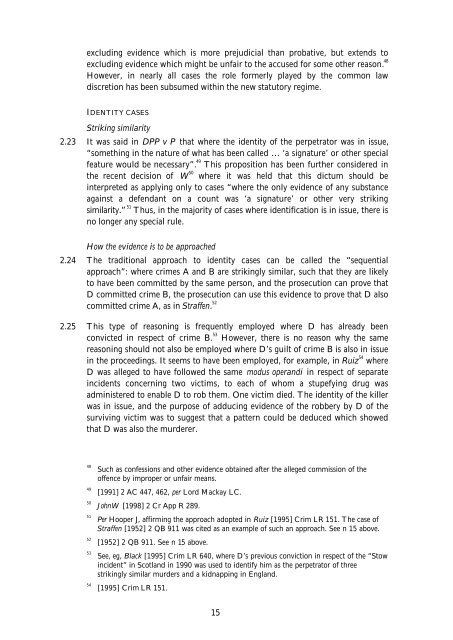Evidence of Bad Character in Criminal ... - Law Commission
Evidence of Bad Character in Criminal ... - Law Commission
Evidence of Bad Character in Criminal ... - Law Commission
Create successful ePaper yourself
Turn your PDF publications into a flip-book with our unique Google optimized e-Paper software.
exclud<strong>in</strong>g evidence which is more prejudicial than probative, but extends to<br />
exclud<strong>in</strong>g evidence which might be unfair to the accused for some other reason. 48<br />
However, <strong>in</strong> nearly all cases the role formerly played by the common law<br />
discretion has been subsumed with<strong>in</strong> the new statutory regime.<br />
IDENTITY CASES<br />
Strik<strong>in</strong>g similarity<br />
2.23 It was said <strong>in</strong> DPP v P that where the identity <strong>of</strong> the perpetrator was <strong>in</strong> issue,<br />
“someth<strong>in</strong>g <strong>in</strong> the nature <strong>of</strong> what has been called … ‘a signature’ or other special<br />
feature would be necessary”. 49 This proposition has been further considered <strong>in</strong><br />
the recent decision <strong>of</strong> W 50 where it was held that this dictum should be<br />
<strong>in</strong>terpreted as apply<strong>in</strong>g only to cases “where the only evidence <strong>of</strong> any substance<br />
aga<strong>in</strong>st a defendant on a count was ‘a signature’ or other very strik<strong>in</strong>g<br />
similarity.” 51 Thus, <strong>in</strong> the majority <strong>of</strong> cases where identification is <strong>in</strong> issue, there is<br />
no longer any special rule.<br />
How the evidence is to be approached<br />
2.24 The traditional approach to identity cases can be called the “sequential<br />
approach”: where crimes A and B are strik<strong>in</strong>gly similar, such that they are likely<br />
to have been committed by the same person, and the prosecution can prove that<br />
D committed crime B, the prosecution can use this evidence to prove that D also<br />
committed crime A, as <strong>in</strong> Straffen. 52<br />
2.25 This type <strong>of</strong> reason<strong>in</strong>g is frequently employed where D has already been<br />
convicted <strong>in</strong> respect <strong>of</strong> crime B. 53 However, there is no reason why the same<br />
reason<strong>in</strong>g should not also be employed where D’s guilt <strong>of</strong> crime B is also <strong>in</strong> issue<br />
<strong>in</strong> the proceed<strong>in</strong>gs. It seems to have been employed, for example, <strong>in</strong> Ruiz 54 where<br />
D was alleged to have followed the same modus operandi <strong>in</strong> respect <strong>of</strong> separate<br />
<strong>in</strong>cidents concern<strong>in</strong>g two victims, to each <strong>of</strong> whom a stupefy<strong>in</strong>g drug was<br />
adm<strong>in</strong>istered to enable D to rob them. One victim died. The identity <strong>of</strong> the killer<br />
was <strong>in</strong> issue, and the purpose <strong>of</strong> adduc<strong>in</strong>g evidence <strong>of</strong> the robbery by D <strong>of</strong> the<br />
surviv<strong>in</strong>g victim was to suggest that a pattern could be deduced which showed<br />
that D was also the murderer.<br />
48 Such as confessions and other evidence obta<strong>in</strong>ed after the alleged commission <strong>of</strong> the<br />
<strong>of</strong>fence by improper or unfair means.<br />
49 [1991] 2 AC 447, 462, per Lord Mackay LC.<br />
50 John W [1998] 2 Cr App R 289.<br />
51 Per Hooper J, affirm<strong>in</strong>g the approach adopted <strong>in</strong> Ruiz [1995] Crim LR 151. The case <strong>of</strong><br />
Straffen [1952] 2 QB 911 was cited as an example <strong>of</strong> such an approach. See n 15 above.<br />
52 [1952] 2 QB 911. See n 15 above.<br />
53 See, eg, Black [1995] Crim LR 640, where D’s previous conviction <strong>in</strong> respect <strong>of</strong> the “Stow<br />
<strong>in</strong>cident” <strong>in</strong> Scotland <strong>in</strong> 1990 was used to identify him as the perpetrator <strong>of</strong> three<br />
strik<strong>in</strong>gly similar murders and a kidnapp<strong>in</strong>g <strong>in</strong> England.<br />
54 [1995] Crim LR 151.<br />
15

















